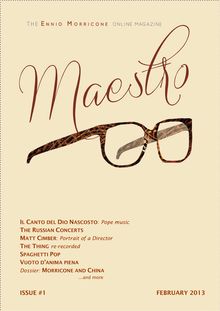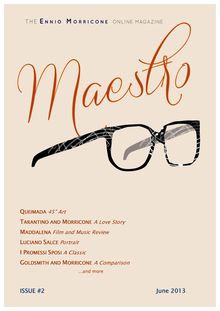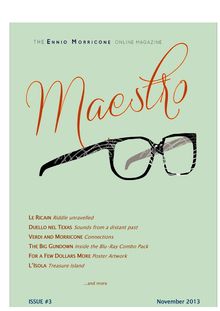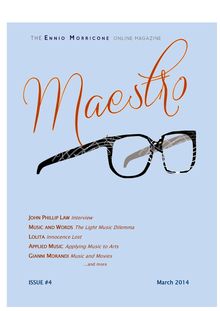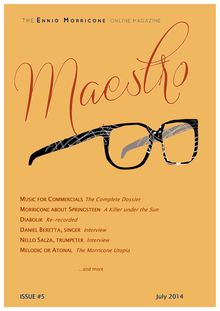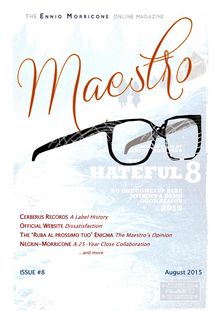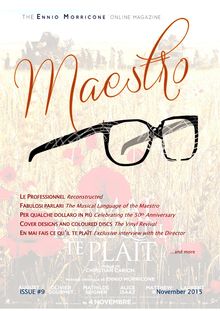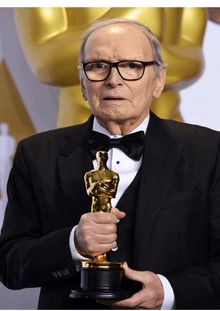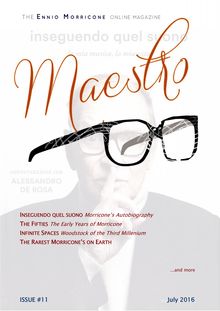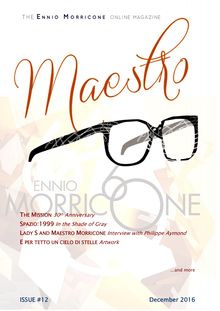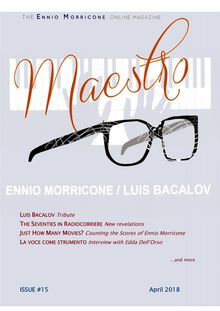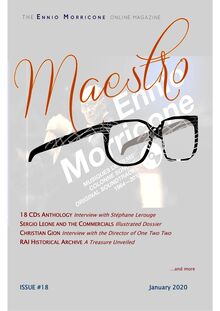-
 Univers
Univers
-
 Ebooks
Ebooks
-
 Livres audio
Livres audio
-
 Presse
Presse
-
 Podcasts
Podcasts
-
 BD
BD
-
 Documents
Documents
-
- Cours
- Révisions
- Ressources pédagogiques
- Sciences de l’éducation
- Manuels scolaires
- Langues
- Travaux de classe
- Annales de BEP
- Etudes supérieures
- Maternelle et primaire
- Fiches de lecture
- Orientation scolaire
- Méthodologie
- Corrigés de devoir
- Annales d’examens et concours
- Annales du bac
- Annales du brevet
- Rapports de stage
La lecture à portée de main
Tout savoir sur nos offres
Tout savoir sur nos offres

Description
NEWS: In breve, Old News, Feedback from Previous Issue, Web News - Didier Thunus, Patrick Bouster et al (5-21)
IN MEMORIAM: Farewell to Alessandro Alessandroni, The Most Famous Western 'Whistle' in the World - Valeria Rusconi, Ernesto Assante [www.repubblica.it] (22-23)
INTERVIEW: Incontro con Alessandro Alessandroni - Patrick Ehresmann (24-28)
ARTWORK AND ANALYSIS: Orca Killer Whale - Steven Dixon (29-30)
IMPRESSIONS: The Dino De Laurentiis Malediction: 40 years to get the music… or not - Patrick Bouster (31-34)
DVD REVIEW: Gillo: Le donne, i cavalier, l’armi, gli amori - Richard Bechet (35-37)
DOSSIER: The Sixties in Radiocorriere, Part 2: Light Music for the Television - Frédéric Durand (38-52)
IN MEMORIAM: Addio Sergio Miceli - Roberto Pugliese [www.colonnesonore.net] (53-54)
ARTWORK AND ANALYSIS: La tenda rossa - Steven Dixon (55-59)
INTERVIEW: Giorgio Carnini, Part 1 of 2: L’organo laico - Patrick Bouster and Mikael Lindgren (60-67)
Sujets
Informations
| Publié par | didier_thunus |
| Publié le | 13 janvier 2018 |
| Nombre de lectures | 10 |
| Licence : |
En savoir + Paternité, pas d'utilisation commerciale, partage des conditions initiales à l'identique
|
| Langue | English |
| Poids de l'ouvrage | 3 Mo |
Extrait
ALESSANDRO ALESSANDRONI R.I.P.
GIORGIO CARNINI, MORRICONE S ORGANIST Interview
LIGHT MUSIC FOR THE TELEVISION Unearthed Arrangements
LA TENDA ROSSA, ORCA Artwork
...and more
ISSUE #13 April 2017
1Table of Contents
Preface........................................................................................................................................ 3
In breve....... 5
Old News.. 13
Feedback from Previous Issue.................................................................................................. 20
Web News ................................ 21
Farewell to Alessandro Alessandroni, The Most Famous Western 'Whistle' in the World ..... 22
Incontro con Alessandro Alessandroni .................................................................................... 24
Orca Killer Whale: Artwork..................................................................................................... 29
The Dino De Laurentiis Malediction: 40 years to get the music… or not ............................... 31
Gillo: Le donne, i cavalier, l’armi, gli amori........... 35
The Sixties in Radiocorriere, Part 2: Light Music for the Television ...................................... 38
R.I.P. Sergio Miceli.................................................................................. 53
La tenda rossa: Artwork........... 55
Giorgio Carnini: Part 1 of 2: L’organo laico............................................ 60
License for all articles: CreativeCommons
Cette œuvre est mise à disposition selon les termes de la Licence Creative Commons Attribution
- Pas d’Utilisation Commerciale - Partage dans les Mêmes Conditions 2.0 Belgique
PUBLICATION PÉRIODIQUE D'ÉTUDE ET DE CRITIQUE DANS LE DOMAINE ARTISTIQUE. LES TEXTES
SONT PUBLIÉS SOUS LA RESPONSABILITÉ DE LEURS AUTEURS, QUI EN CONSERVENT LA PROPRIÉTÉ
DES DROITS D'AUTEUR ET INTELLECTUELS.
All the articles are of purely informative nature. We do not own the copyright of the images
included in this document or of the audio clips accessible from it. All the rights on the images
and the music are the property of their respective owners.
Chief editors: Patrick Bouster and Didier Thunus
Front cover design: Valeria Magyar
Front cover inlay: Anne-Catherine Mortiaux
Front cover image: Picture of Alessandro Alessandroni in the Fifties
Back cover: «Ennio» (2016), watercolour by Philippe Aymond
2MAESTRO – THE ENNIO MORRICONE ONLINE MAGAZINE ISSUE #13 APRIL 2017
P REFACE
Vintage or Intemporal
by Didier Thunus
If young people love the music of Ennio Morricone today, it is clearly because it is either vintage or
intemporal. It is definitely not because he has been able to follow recent trends in music and to adapt his
style to the kind of music young people like to listen to today. He hasn’t. Whenever he has tried to do that,
it was upon specific request from a director, and he needed help from younger musicians: in the Seventies,
when he had to do some disco music, he was helped by the likes of Centofanti, Meakin and Fraser (cf. Cosi
come sei, 1978); in the Nineties, when he had to introduce rock sounding percussions, he called upon his
son Andrea (cf. Ultimo, 1998); in the 2000s, when he was asked to use electro metal sounds, he made use
of the skills of Rocco Petruzzi (cf. La sconosciuta, 2006). On the other hand, I don’t know of any other
artist who has been able to follow the movement of the ever-changing music predilections of any period. It
would require a high level of adaptability, to be able to cater for the new tastes but also for the new
techniques of music creation. Above all, it would probably also mean that the composer would have to
compromise with his own deep aspirations and with his most profound and inherent nature. And
compromising is not something Ennio Morricone does. When he endorses an assignment, he becomes
impregnated with the subject matter and develops his ideas with his own personal inventiveness and
creativity. There are constraints of course, always – even with absolute music, there are constraints. But
Morricone always comes up with his own solutions, never with a copy or a reuse of someone else’s ideas
or with fashionable material.
1Therefore, if he is still appreciated today by younger audiences , it can only be for the two reasons I
mentioned. Vintage music means music created long ago that, when listened to today, evokes faraway times
when things seemed to be so much better than what they have become. People who are dissatisfied with
their condition will often find comfort in forgotten artefacts. It will also often be a way for them to stand
out from the masses who all dig the same modern crap. Besides, they have the possibility to take a step
back and look at those ancient artworks with fresh eyes, realizing how outstanding they were. This is when
the term “vintage” takes all its dimension. And much of Ennio Morricone’s music from the Sixties or
Seventies, probably up until The Untouchables (1987), is pure vintage. He completely belongs to the
vintage arena which the youth savour today. Look at the vinyl revival: he is one of the artists most
represented on that support. We used to have to look for the category “film music” in disc shops in order
to find his albums. Today we just have to look for the letter “M”. A few weeks ago I had my 13yo daughter
listen to the 33rpm of René la Canne (1976), and she enjoyed it. I don’t think I would have managed to
2have her listen to the CD!
I also had a similar feeling when watching the ovation that Jean-Paul Belmondo received at the César
ceremony last February. That guy was by far not the preferred actor of the critics in the Seventies or Eighties,
and that’s an understatement. He was even mocked by many respectable filmgoers and professionals, and
always overlooked by voters. And today, it is exactly those people who were standing for him in the
audience for a never-ending applause and a very moving moment. The truth is that they are not exactly the
same people: they are their children, their successors. It is those people who were kids in the Eighties and
still had the capacity to rejoice with futilities and to get excited without having to think about why they
1 I’m not talking about older ones, like myself. We are simply irrevocably hooked inside the golden prison of
fondness for the music that has accompanied our lives for so many years.
2 On this matter I don’t really understand why some record companies publish coloured vinyls, like the recent
edition of Bluebeard on a blue disc. A vinyl plate should be black, otherwise it is not vintage anymore.
3MAESTRO – THE ENNIO MORRICONE ONLINE MAGAZINE ISSUE #13 APRIL 2017
were getting excited. That night, there was clearly no judgment, no distrust: Jean-Paul Belmondo was the
champion of French cinema. And for many reasons, Morricone and Belmondo are in the same league.
Intemporal is said of things that are independent from time, that do not change when time passes. Those
things will always be considered beautiful by most people because they evoke undefinable universes of
infinite beauty. They come from the beyondness of things. They are La califfa, Marco Polo, or La
Venexiana. They are Gabriel’s Oboe, Chi mai, or Jill’s Theme. If you are reading this fanzine anyway, I
don’t think I need to say much more about these – I know you are with me already. I don’t expect these to
ever become vintage, because being vintage clearly means being anchored in time. They come from an
unseen source, from the heavens – the composer is like the moon that seems to illuminate the earth at night,
when actually it only reflects the light from an unseen origin.
There is no question about how popular Ennio Morricone is today, when we see the massive crowds that
continue to queue up for his live concerts, even after so many years of touring and even in the cities where
he played several times already. As a side note I can also testify that when the movie The Good, the Bad
and the Ugly was played again in a cinema in Brussels this year, the room was packed with people of all
ages. Yes, Sergio Leone is vintage and intemporal as well.
Another proof of the intemporality of our Maestro is that the News section of this fanzine grows bigger and
bigger each time. This is partly due to the ever-growing information published on the internet, and to the
many contributions of our usual dauntless collaborators, but also to the sustained interest that Ennio
Morricone is able to attract.
In this issue, Frédéric continues his painstaking exploration of the Radiocorriere TV/radio magazine and
things are getting really serious now with the second part on the Sixties: he was able to gather a quite
impressive list of titles which had never been known to be part of Morricone’s repertoire. If the previous
articles were not able to dismiss all doubts about Ennio’s involvement in the cited songs, because of the
incomplete nature of such an unspecialized and dated document, this time there was enough evidence to
come up with a solid enumeration of newly discovered arrangements. And that’s not the end of it: I have
already read the third part, to be published in Maestro #14, and I can already tell you that there are
-
 Univers
Univers
-
 Ebooks
Ebooks
-
 Livres audio
Livres audio
-
 Presse
Presse
-
 Podcasts
Podcasts
-
 BD
BD
-
 Documents
Documents
-
Jeunesse
-
Littérature
-
Ressources professionnelles
-
Santé et bien-être
-
Savoirs
-
Education
-
Loisirs et hobbies
-
Art, musique et cinéma
-
Actualité et débat de société
-
Jeunesse
-
Littérature
-
Ressources professionnelles
-
Santé et bien-être
-
Savoirs
-
Education
-
Loisirs et hobbies
-
Art, musique et cinéma
-
Actualité et débat de société
-
Actualités
-
Lifestyle
-
Presse jeunesse
-
Presse professionnelle
-
Pratique
-
Presse sportive
-
Presse internationale
-
Culture & Médias
-
Action et Aventures
-
Science-fiction et Fantasy
-
Société
-
Jeunesse
-
Littérature
-
Ressources professionnelles
-
Santé et bien-être
-
Savoirs
-
Education
-
Loisirs et hobbies
-
Art, musique et cinéma
-
Actualité et débat de société
- Cours
- Révisions
- Ressources pédagogiques
- Sciences de l’éducation
- Manuels scolaires
- Langues
- Travaux de classe
- Annales de BEP
- Etudes supérieures
- Maternelle et primaire
- Fiches de lecture
- Orientation scolaire
- Méthodologie
- Corrigés de devoir
- Annales d’examens et concours
- Annales du bac
- Annales du brevet
- Rapports de stage
